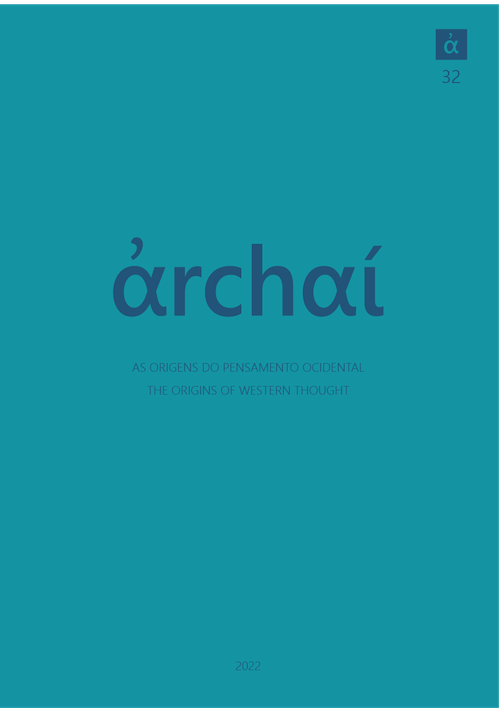Dialectic and Refutation in Plato.On the Role of Refutation in the Search for Truth
DOI:
https://doi.org/10.14195/1984-249X_32_14Keywords:
dialectic, refutation, hypothesis, self-refutation, principlesAbstract
While refutation is usually related to Plato's early, Socratic, dialogues, this paper is aimed at exploring the link between refutation and dialectic in some of his middle and late dialogues. First, it argues that refutation assumes a constructive role in the Phaedo, where the best logosis the least refutable, and also in the Republic, where the philosopher is invited to fight his way through all elenchoi. Then, it tries to show that the gymnasiaof Prm. 130a ff. is aimed at training young Socrates to come to the aid of the theory he embraces preventing it from being refuted.He should travel and explore all the paths, by assuming a hypothesis as well as the opposite one. This methodology paves the way on which Plato advances in the Sophist, where the antinomic structure of the gymnasiagives way to a “constructive” dialectic inwhich the aporia is solved and a thesis is established by refutation. The last section of this paper is devoted to analysing Sph. 251c-252e, where the positive and constructive function of the elenchus is especially clear. Plato argues for the symploke eidonby exploring all the hypotheses that are open to the search and refuting those that ultimately represent obstacles to his position. The symplokeis the truth which remains when all the hypotheses that contradict it have been refuted. The conclusion is that theelenchus does not disappearbut is put at the service of the truth, as an essential part of the method for attaining apositive doctrineDownloads
References
ADAM, J. (1963). The Republic of Plato. Edited with Critical Notes, Commentary, and Appendices. Vol. II: Books VI-X and Indexes. Cambridge University Press (1ed. 1902).
ALLEN, R. E. (1983). Plato’s Parmenides. Translation and Analysis. Minneapolis, University of Minnesota Press.
BALTZLY, D. (1996). To an Unhypothetical First Principle. History of Philosophy QuarterlyXIII, n. 2, p. 146-165.
BALTZLY, D. (1999). Aristotle and Platonic Dialectic in MetaphysicsIV 4. Apeiron: A Journal for Ancient Philosophy and Science32, p. 171-202.
BARNES, J. (1982). The Presocratic Philosophers. The Arguments of the philosophers.London,Routledge.
BERNADETE, S. (1984). The Being of the Beautiful. Plato’s Theaetetus, Sophist and Statesman(Translated and with Commentary). Chicago/London, University of Chicago Press.
BERTI, E. (2015). Contraddizione e dialettica negli antichi e nei moderni. Brescia, Morcelliana.
BLUCK, R. S. (1975). Plato’s Sophist. A Commentary. Manchester, ManchesterUniversity Press.
CASERTANO, G. (2015). Platone, Fedone, o dell’anima. Dramma etico in tre atti (Traduzione, commento e note). Napoli, P. Loffredo.
CASTAGNOLI, L. (2010).Ancient Self-Refutation. The Logic and History of the Self-Refutation Argument from Democritus to Augustine. Cambridge, Cambridge University Press.
CORNFORD, F. (1939). Plato and Parmenides’Way of Truth and Plato’s Parmenides. London, Routledge / Kegan Paul.
CROSS, R. C.; WOOZLEY, A. D. (1964).Plato’s Republic. A Philosophical Commentary. London, MacMillan.
DIXSAUT, M. (1991).Plato.Phédon (traduction, introduction et notes).Paris, GF-Flammarion.
EGGERS LAN, C. (1983).Fedón de Platón.Buenos Aires, Editorial Universitaria de Buenos Aires(1ed. 1971).
FERRARI, F. (2016).Platone.Parmenide(testo greco a fronte).Milano, Biblioteca UniversaleRizzoli(1ed.2004).
FRONTEROTTA, F. (2007). Platone.Sofista(testo greco a fronte). Milano, Biblioteca UniversaleRizzoli(1ed. 2004).
GALLOP, D. (1975). Plato.Phaedo(translated with notes). Oxford, Clarendon Press.
GONZALEZ, F. (1998). Dialectic and Dialogue. Plato’s Practice of Philosophical Inquiry. Evanston, Northwestern University Press.
GRIFFITH, T. (2000) Plato. The Republic. Edited by G. R. F. Ferrari. Cambridge, CambridgeUniversity Press.
HACKFORTH, R. (1994) Plato.Phaedo(translated with an introduction and commentary).Cambridge, CambridgeUniversity Press (1ed. 1955).
HEINAMAN(1983).Communion of Forms”.Proceedings of the Aristotelian Society. New Series 83, p. 175-190.
KAHN, C. (2003). Plato and the Post-Socratic Dialogue. The Return of the Philosophy of Nature. Cambridge, Cambridge University Press.MARCOS, G.(2014).Platón, el “padre Parménides” y la criatura sofística. In:MARCOS, G.; DÍAZ, M. E. (eds.), El filósofo y sus adversarios en los escritos de Platón y Aristóteles. Buenos Aires, Editorial Rhesis, p. 118-135.
MARCOS DE PINOTTI, G. (2017). Lenguaje y ser en Platón. Sobre cómo refutar a un adversario radical.Hypnos39, 2, p. 141-159.
OWEN, G. (1972).Plato on Not-Being. In Vlastos, G. (ed.), Plato: A Collection of Critical Essays, vol. I.London, MacMillan, p. 223-267.
PECK, A. (1962). Plato’s Sophist. The symplokétõn eidõn.Phronesis7, 1, p. 46-66.
ROBINSON, R. (1953).Plato’s Earlier Dialectic. 2nded. Oxford, ClarendonPress (1ed. 1941).
SCHOFIELD, M. (1977). The Antinomies of Plato’s Parmenides.The Classical Quarterly27, 1, p. 139-158.
SLINGS, S. R. (2003) Platonis Rempublicam recognovit brevique adnotatione critica instruxit, Oxford, Oxford University Pres.
VALLEJO CAMPOS, A. (2018). Adonde nos lleve ellogos. Para leer laRepública de Platón.Madrid, Editorial Trotta.
VIGO, A. G. (2009).Platón.Fedón (traducción, notas e introducción). Buenos Aires, Colihue Clásica.
WILMET, R. (1990). Platonic Forms and the Possibility of Language.Revue de Philosophie AncienneVIII, 1, p. 97-118.
Downloads
Published
How to Cite
Issue
Section
License
Copyright (c) 2022 Graciela Marcos

This work is licensed under a Creative Commons Attribution 4.0 International License.
Given the public access policy of the journal, the use of the published texts is free, with the obligation of recognizing the original authorship and the first publication in this journal. The authors of the published contributions are entirely and exclusively responsible for their contents.
1. The authors authorize the publication of the article in this journal.
2. The authors guarantee that the contribution is original, and take full responsibility for its content in case of impugnation by third parties.
3. The authors guarantee that the contribution is not under evaluation in another journal.
4. The authors keep the copyright and convey to the journal the right of first publication, the work being licensed under a Creative Commons Attribution License-BY.
5. The authors are allowed and stimulated to publicize and distribute their work on-line after the publication in the journal.
6. The authors of the approved works authorize the journal to distribute their content, after publication, for reproduction in content indexes, virtual libraries and similars.
7. The editors reserve the right to make adjustments to the text and to adequate the article to the editorial rules of the journal.



